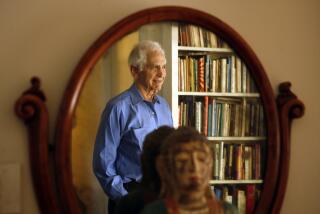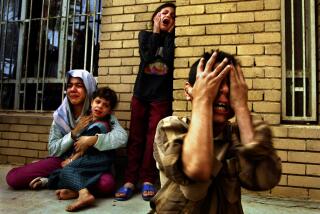Did Non-Meeting of Minds Result in War?
- Share via
It was a turning point in history. Two people meet in a room for two hours. Afterward, a war is launched.
A half-million Americans go to battle, billions of dollars are spent, tens of thousands of people die.
So what happened in that room? What really happened in that two-hour meeting last year between Iraqi President Saddam Hussein and American Ambassador April Glaspie?
We are just now finding out the truth of it. Secret cables have been released. Charges are flying. Defenses are being readied.
We know that Glaspie, a 25-year veteran of the Foreign Service, was summoned to the Presidential Palace in Baghdad July 25, 1990. It was to be the first private meeting she had with Saddam, even though she had been in the country for two years.
She is alone. Saddam is in uniform, wearing a side arm. Glaspie asks him to take the gun off. He does, handing it to an aide. The meeting begins.
Critics of the Bush Administration characterize what follows as a tragic bungle: Glaspie acts as an appeaser who fails to warn Saddam that an invasion of Kuwait will not be tolerated by the United States.
Glaspie denies this. She claims she was tough toward Saddam, repeatedly warning him against taking military action.
Seven days after the meeting, Glaspie, her mother and her dog leave Baghdad so Glaspie can attend a week of briefings in Washington. Stopping off in London, she turns on the TV in her hotel room to find that Saddam has just invaded Kuwait.
Later, Iraq releases a transcript of the Saddam-Glaspie meeting that shows Glaspie did not deliver any strong warnings to Saddam.
Later, Glaspie tells Congress that the Iraqi transcript is a “fabrication” and that she had delivered repeated warnings.
Recently, however, David Hoffman of the Washington Post obtained Glaspie’s cables to Washington reporting on the fateful meeting. These cables indicate that Glaspie delivered no strong warning to Saddam and that the Iraqi transcript may be closer to the truth than Glaspie’s account to Congress.
One senator has already charged Glaspie with deliberately misleading Congress and the nation. Others are saying the Bush Administration mistakenly gave Saddam a green light to invade Kuwait.
Did the Persian Gulf War really originate from a botched meeting? Is Glaspie being made a scapegoat for the Bush Administration’s prewar policy toward Saddam? Would Saddam have listened to U.S. warnings anyway?
And just who were these two people who met for these two critical hours, facing off before history?
I have gone through the profiles, the wire service reports, the newspaper accounts and the transcripts to match up these two contenders. Here is the tale of the tape.
On one side we have Saddam Hussein, a 53-year-old ex-intelligence officer and former street-gang member given to wearing elegant suits and military uniforms.
On the other side, we have April Glaspie, 48, a Canadian-born Californian given to conservative clothing, “simple gold earrings, little makeup and short, unpolished nails.”
Saddam is a vain man who likes to hand out expensive Rolex watches with his picture on them.
Glaspie’s one vanity, according to a newspaper account, “is her hair, long and flowing.” Another account refers to it as “graying auburn.” (In no account could I find a description of Saddam’s hair.)
Words used to describe April Glaspie: warm , blunt , funny , brilliant , stubborn and unyielding .
Words used to describe Saddam Hussein: evil , mad , paranoid , Hitlerian , stubborn and unyielding .
Saddam, born into poverty, was prevented from going to school by a cruel stepfather. At 20, Saddam became an assassin for the Baath Party. His first victim was a communist activist who happened to be his brother-in-law.
Glaspie, an only child, attended Mills College and the Johns Hopkins School of Advanced International Studies. She entered the Foreign Service and was posted to Amman, Jordan; Kuwait; Stockholm; Beirut, Lebanon; Cairo, Egypt; London; New York, and Damascus, Syria.
Wounded in a shootout, Saddam carved the bullet out of his leg without an anesthetic.
As the ranking American envoy in Damascus in 1985, Glaspie helped negotiate a hostage release and was called a “genuine heroine.”
Saddam became president of Iraq following bloody coups. Under his rule, anyone suspected of disloyalty--this includes the accidental spilling of coffee on his newspaper photo--is subject to arrest, torture and execution. Entire towns have had their populations killed and their buildings bulldozed. Poison gas was used against the Kurdish minority in Iraq. Saddam began a “supergun” artillery program, and a nuclear and chemical weapons program.
April Glaspie became the first woman to head an embassy in the Middle East.
Saddam distrusts reporters. Before they interview him, their pens are taken apart to check for explosives, and they must dip their hands in a blue chemical solution in case they are trying to kill him with contact poison delivered by handshake.
Glaspie helps ABC’s Diane Sawyer get an interview with Saddam. The Iraqi transcript of Glaspie’s meeting with Saddam has Glaspie telling him that the ABC interview “was cheap and unjust.”
In front of Congress, however, Glaspie says the Iraqis have altered the transcript and that, in fact, she told Saddam the editing was cheap and unjust. A day later, Glaspie says Sawyer “did American journalism proud.” In Glaspie’s secret cable to Washington, however, she says she “had seen the Diane Sawyer show and thought it was cheap and unfair.”
Saddam Hussein was born April 28, 1937.
April Glaspie was born April 26, 1942.
Both are Taureans, said to be stubborn and unyielding.
Saddam Hussein’s most ironic quotation came in January, 1991, a few weeks before the American bombing began. “I know I am going to lose,” he said. “At least I will have the death of a hero.”
April Glaspie’s most ironic quotation came in September, 1990, after she was stuck behind a desk in the State Department. She was asked by a reporter whether she would like to return to Baghdad. “God,” she replied, “I wish I were there.”
What exactly happened between Glaspie and Saddam may never be known. But some think Glaspie will never get another ambassadorship because she has become a political embarrassment.
This fall, April Glaspie will take a leave of absence to become ambassador-in-residence at the University of California, San Diego.
Saddam Hussein is still president of Iraq.
More to Read
Sign up for Essential California
The most important California stories and recommendations in your inbox every morning.
You may occasionally receive promotional content from the Los Angeles Times.










